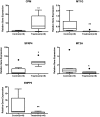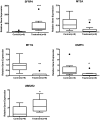Compartmentalized gene expression profiling of receptive endometrium reveals progesterone regulated ENPP3 is differentially expressed and secreted in glycosylated form
- PMID: 27665743
- PMCID: PMC5036034
- DOI: 10.1038/srep33811
Compartmentalized gene expression profiling of receptive endometrium reveals progesterone regulated ENPP3 is differentially expressed and secreted in glycosylated form
Abstract
The complexity of endometrial receptivity at the molecular level needs to be explored in detail to improve the management of infertility. Here, differential expression of transcriptomes in receptive endometrial glands and stroma revealed Ectonucleotide Pyrophosphatase/Phosphodiesterase 3 (ENPP3) as a progesterone regulated factor and confirmed by various methods, both at mRNA and protein level. The involvement of ENPP3 in embryo attachment was tested in an in vitro model for human embryo implantation. Interestingly, there was high expression of ENPP3 mRNA in stroma but not protein. Presence of N-glycosylated ENPP3 in receptive phase uterine fluid in women confirms its regulation by progesterone and makes it possible to use in a non-invasive test of endometrial receptivity.
Figures








References
LinkOut - more resources
Full Text Sources
Other Literature Sources

